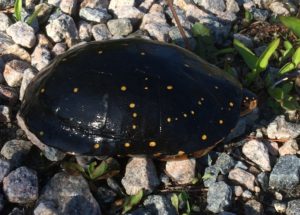Now is the time for the Great Swamp

Blue-gray Gnatcatcher on nest. Photo: jimburnsphoto.com
Now is the time. No too hot yet, not too buggy. Tree leaves haven’t quite bloomed, so there is a bit of shade, but not enough to obscure the view. There’s an awakening that is taking place among the residents, and more company arrives every day. Some will stay, some will pass through to cooler climes. But now is the time.
The Great Swamp Management Area (GSMA) in South Kingstown is arguably at its best right now, at this moment. Its 3500 acres are stirring with every variety of life: wild plants and flowers have crept forth from the matted litter of their winter beds. Reptiles and amphibians sense the warming sun and have begun to eat, to mate, and to travel to nesting locations. And the birds? Well, the birds are into the third act of their spring performance. More on that later.
Since 1950, the Great Swamp has been under the watchful eye of the Department of Environmental Management. Purchased through the Federal Aid in Wildlife Restoration program, the parcel is maintained for a balance of both hunters and hobbyists. An impoundment of 140 acres provides waterfowl, beavers, turtles, and a host of other animals an aquatic environment. GSMA is also host to trees like red maple, Atlantic white cedar, red oak, white oak, white pine, and American holly. A walk through the GSMA can take 30 minutes or several hours, depending on the visitor’s enthusiasm, and trails are easy and flat.
Within a hundred feet from the dirt parking lot, the woods open up to a marsh. To the left is a vista of trees, shrubs, and water, all of which harbor life. To the right, a small wet area makes a home for a variety of frogs and turtles. On this same trip, a painted turtle sat in the middle of the trail, its shell still wet from the watery marsh on the left. While it’s impossible to know what its motivation was for moving across the open (and vulnerable) trail, turtles often move off to nesting areas at this time of year to lay their eggs.

A Spotted turtle, still wet from crawling out of the nearby water, patiently waits for the photographer to move on. Photo: Hugh Markey
But perhaps the most popular reason people wander through the GSMA at this time of year is for the birds. Dozens of varieties have been arriving for weeks, some for the season, others stopping for refueling on their way further north for nesting. This is the place to see raptors like Red tail hawks, along with the spectacular ospreys, who make their ten-foot nests out of sticks arranged at the tops of open poles and trees. Brilliantly colored Baltimore orioles frequent the upper parts of the trees, their loud whistles calling in potential mates and warding off potential competitors. Dozens of varieties of warblers, as colorful as they are small, flit from bramble to branch in an assortment of levels, calling in mates and building nests. Buy/bring/borrow a pair of binoculars and the canopies will reveal an amazing experience.
In the dense brush next to a trail, I heard a rustling sound. Training my binoculars on the source, I found a Blue-gray gnatcatcher, quickly moving from spot to spot. It flew out of the brush to a place nearly directly above me, where it was joined by another gnatcatcher. The pair seemed focused on a small fork that formed between two mid-sized branches. In a moment, the male came down to the same spot where I had first seen him. After watching this process several times, I realized that I was witnessing a behavior that I had never seen: the male had found a tiny nest in the thick brush. Several times, he would hop below the nest, reach up with his beak, and pluck chunks out of it. Once he had done this several times, he would bring the loot to the upper reaches of the tree, where he and his mate would carefully arrange the stolen goods into the foundation for a new nest. It’s a competitive world.
Yet sights like that will become increasingly difficult to observe. Smaller bird species like the warblers will soon be obscured by the leaves that continue to emerge daily. Like a group of actors on a stage, the curtain has started to fall. Of course, most of the birds will continue to be there, but seeing them as they flit through the leafy shrubs and trees may become an exercise in futility.
After wandering the trails for several hours, I had nearly reached the parking lot when I came across an older couple. Both had binoculars around their necks, and the woman said, “Did you see anything wonderful today?” If you go right now, when the time is just right, the answer to that question is nearly guaranteed to be yes.
Maps of DEM properties can be found at http://www.dem.ri.gov/maps







Nice! I’ve never seen that behavior in Blue-grey Gnatcatchers before.
Also, your turtle is actually a Spotted Turtle. They are a threatened species in RI, and classified as Endangered by the IUCN. They seem to be doing quite well at Great Swamp and around there though; I’ve seen them there a lot in the past few years.
Thanks for the pickup, Dylan! I’ve made the correction in the story, and it’s great to hear that they’re doing well. Glad you took time to write.